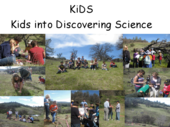Highlight
Scientists, schoolchildren, and serpentine grasslands
Achievement/Results
Climate change is likely to affect California ecosystems in complex ways because of interactions between precipitation timing, nitrogen deposition, and invasive species. At the McLaughlin Natural Reserve, Anu Eskelinen (UC Davis and University of Oulu, Finland) and Susan Harrison (UC Davis) have initiated a study to examine the interactive effects of simulated climate change and nutrient addition on both serpentine and non-serpentine grasslands. REACH IGERT student Kelly Gravuer (UC Davis) is collaborating with Eskelinen and Harrison to understand belowground impacts of these changes.
Serpentine soils are typically low in the moisture and nutrients essential for plant growth and often contain unusually high concentrations of heavy metals. As a result, serpentine soils tend to harbor unique communities of native plants able to withstand the harsh conditions. Historically, this harsh environment has largely resisted invasion by the non-native plants that have overtaken other California native grasslands. However, deposition of nitrogen from human activities may lead to increased soil fertility that enables weedy non-native species to become established. Furthermore, the predicted increase in late spring rainfall may exacerbate invasion by lengthening the season over which plants can access the additional nutrients. By documenting responses to simulated late spring rainfall and supplemental nutrients in experimental plots at the McLaughlin Reserve, the team of researchers hopes to clarify these impacts on both plant and soil communities.
Postdoctoral researcher Eskelinen and Professor Harrison have been and are continuing to carefully monitor plant community responses to the experimental treatments. They are particularly interested in whether serpentine and non-serpentine communities respond in the same way and in how plant traits may mediate these responses. Gravuer, a doctoral candidate in the NSF-funded Responding to Rapid Environmental Change (REACH) IGERT, is examining soil processes and microbial communities. She is focusing on whether soil microbial changes parallel those of plants across soils and treatments, or whether the responses of these two closely interacting communities diverge. Together, these collaborators hope to understand how plant and soil microbial community responses interact to drive changes in key ecosystem functions such as productivity, nutrient cycling, and decomposition. A large share of the project is funded by the Finnish Academy of Sciences.
Amid these experimental plots, each April the McLaughlin Reserve hosts a field day for nearly 100 5th grade students from nearby Lower Lake Elementary, a rural school with many students in difficult economic circumstances. This trip is the annual culmination of the Kids into Discovering Science (KiDS) program, co-founded in 2010 by Kara Moore, Barbara Going, and Maureen Stanton, all (then) of UC Davis. Prior to the field day, the students are engaged in classroom lessons where they generate hypotheses about plant growth in serpentine vs. non-serpentine soil, then test them by planting seeds in the two soil types and analyzing growth data. REACH Associate Katie Eskra played a major role on this year’s KiDS leadership team, matching volunteers with appropriate tasks and coordinating the field day. Eskra and Gravuer were also among this year’s classroom teachers, teaching interactive lessons on California habitats and summarizing data. At the field day, small groups of students (accompanied by a mentor) rotate through several hands-on activity stations highlighting the biodiversity and the ecology of serpentine systems.
REACH trainees Noam Ross and Rosemary Hartman led activity stations focusing on predator-prey relationships and aquatic biodiversity, respectively. At these stations, students compared the ease of finding prey in serpentine vs. non-serpentine grasslands and made up-close observations of the aquatic food web at McLaughlin. Eskra and Gravuer also served as field day mentors, leading the students among stations. Many of the field trip activities actually took place among the Eskelinen/Harrison experimental plots. Activity station leaders and mentors guided students in observing the effects of the experimental treatments and discussed why and how researchers design experiments to understand impacts of climate change. These activities provided a unique opportunity for the students to see science in action.
Address Goals
Climate change and nitrogen deposition resulting from increased automobile use in California have the potential to exacerbate spread of non-native plants in formerly pristine areas. The research in experimental plots will lend insight into the effects of combined additions of soil nitrogen and late spring precipitation on both above-ground plants and soil microbes. The KiDS outreach program targets schoolchildren in Lake County, a rural region with large numbers of students from under-represented economic and ethnic groups. UC Davis ecologists conducting studies within the McLaughlin Natural Reserve may be the only scientists that these students encounter unless they leave their community to attend college. Thus, an outreach program that combines hands-on investigation with visits to a natural area has the potential to make science tangible and seem like a possible career path for these children.







